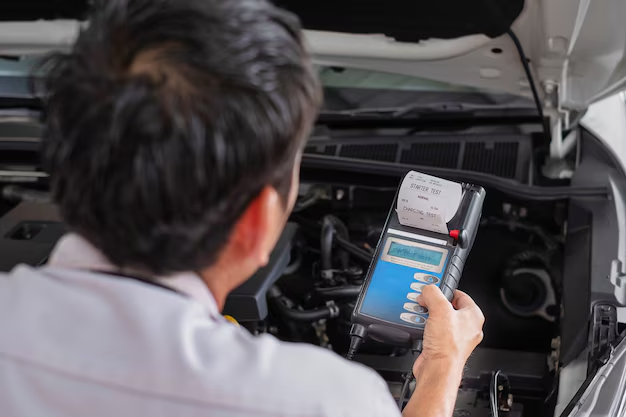Modern vehicles are more sophisticated than ever before, equipped with complex systems that work together to deliver performance, safety, and efficiency. But when something goes wrong, pinpointing the exact cause isn’t as simple as it used to be. Gone are the days when a quick look under the hood and a few turns of a wrench could diagnose most problems. Today, advanced diagnostic tools and techniques are essential to troubleshoot car issues quickly and accurately.
At ASAP Automotive & Transmission in Bear, Delaware, we’ve embraced this technology to provide our customers with reliable answers and efficient repairs. From decoding the meaning behind a check engine light to identifying hidden issues before they become expensive problems, modern diagnostics help keep your vehicle running at its best.
Let’s take a closer look at how these tools work, why they matter, and how they can save you time, money, and frustration.

Why Modern Vehicle Diagnostics Are a Game-Changer
In the past, mechanics often had to rely on trial and error to figure out what was wrong with a vehicle. While experience played a big role, guessing still took time, and sometimes repairs had to be redone when the first attempt didn’t solve the problem.
With advanced diagnostic scan tools, things are different. These tools communicate directly with your car’s onboard computer systems to read error codes, monitor real-time data, and detect irregularities. This means:
- Faster problem detection – No wasted time guessing.
- More accurate repairs – Technicians know exactly what needs fixing.
- Cost savings – Less time in the shop means lower labor costs.
It’s like having your vehicle tell the technician exactly where it hurts.
The Role of the OBD-II System
One of the most important breakthroughs in diagnostics was the introduction of the OBD-II (On-Board Diagnostics II) system in the mid-1990s. This standardized interface is now found in every modern car and truck.
When your check engine light turns on, it’s the OBD-II system’s way of saying, “Something’s not right.” Using a compatible scanner, technicians can access a range of information, including:
- Trouble codes that point to the system or component causing the issue
- Live data from sensors throughout the engine, transmission, and exhaust systems
- Readiness monitors that show whether emissions-related components are functioning properly
For example, if your check engine light comes on due to a faulty oxygen sensor, an OBD-II scan can identify the sensor in question. That allows the mechanic to replace it without tearing apart the entire exhaust system to find the problem.
Types of Diagnostic Scan Tools
Not all diagnostic tools are created equal. At ASAP Automotive & Transmission, we use professional-grade equipment to get the most accurate results possible. These include:
- Basic Code Readers
These devices pull the trouble codes stored in your car’s computer. While they’re helpful for a quick read, they don’t provide the level of detail professionals need for complex repairs. - Professional OBD-II Scanners
These advanced tools go beyond reading codes. They display live sensor data, perform system tests, and allow technicians to reset warning lights after repairs. - Manufacturer-Specific Scan Tools
Certain vehicles have proprietary systems that require brand-specific diagnostic tools. These offer even deeper access to vehicle data, enabling pinpoint repairs for makes like Ford, GM, Toyota, or BMW. - Oscilloscopes and Multimeters
For electrical and sensor-related issues, these tools help analyze voltage patterns and circuit continuity, often revealing problems invisible to basic scans.
Beyond the Check Engine Light
While most people think of diagnostic scans as something you do when the check engine light comes on, their value goes far beyond that. Modern diagnostic equipment can detect:
- Transmission performance issues before they cause shifting problems
- Brake system irregularities, including ABS malfunctions
- Airbag and safety restraint system errors
- HVAC system failures affecting heating and cooling performance
- Fuel system inefficiencies that lower gas mileage
This means you don’t have to wait for a warning light to pop up before taking action. Regular diagnostic checks can uncover small issues early, preventing breakdowns and costly repairs later.
Real-World Example: How Diagnostics Save Time and Money
Imagine your car starts running rough and struggling to accelerate. Without diagnostics, a mechanic might need to inspect multiple systems—fuel delivery, ignition, exhaust—before finding the culprit. This could take hours of labor, driving up the repair bill.
With a professional OBD-II scan, the technician can see that a particular cylinder is misfiring due to a faulty ignition coil. The repair becomes faster, more precise, and more affordable.
At ASAP Automotive & Transmission, we’ve seen countless cases where advanced diagnostics cut repair time in half and saved our customers from replacing parts that weren’t actually broken.
How ASAP Automotive & Transmission Makes Diagnostics Better
While technology is a critical part of accurate problem detection, the tools are only as good as the hands that use them. Our ASE Certified technicians combine decades of experience with cutting-edge equipment to provide:
- Accurate troubleshooting that gets to the root of the issue
- Clear explanations so you understand what’s wrong and how it will be fixed
- Efficient repairs that minimize downtime without sacrificing quality
And because we’ve been serving Bear, Delaware since 1966, we know the local driving conditions and common vehicle issues in the area. That local knowledge adds another layer of accuracy to our diagnostics.
Preventive Diagnostics: Catch Problems Before They Escalate
Just like routine oil changes keep your engine healthy, periodic diagnostic scans can keep your entire vehicle in top shape. Think of it as a health checkup for your car.
Preventive diagnostics can help you:
- Identify worn components before they fail completely
- Maintain peak fuel efficiency
- Reduce the risk of sudden breakdowns
- Extend the life of your vehicle
A quick scan once or twice a year—especially before long trips—can give you peace of mind and save you from roadside headaches.
When to Schedule a Diagnostic Check
Here are some situations when it’s smart to bring your vehicle in for a scan:
- Check engine light or other dashboard warning indicators turn on
- Unusual performance issues like stalling, hesitation, or rough idling
- Strange noises from the engine, transmission, or brakes
- Poor fuel economy without an obvious cause
- Before buying a used car to ensure it’s in good shape
Even if your vehicle seems to be running fine, an occasional scan can reveal problems you might not notice yet.
For more than 55 years, ASAP Automotive & Transmission has been helping drivers in Bear and the surrounding Delaware communities keep their vehicles safe, reliable, and efficient. If your check engine light is on, your vehicle isn’t performing like it should, or you just want the reassurance of a preventive diagnostic check, we’re here to help.
Our combination of state-of-the-art scan tools, ASE Certified expertise, and commitment to honest service ensures that you’ll get accurate answers and dependable repairs every time. Call us today or stop by our shop to experience the ASAP difference and get your vehicle back on the road with confidence.

